
- Retrait gratuit dans votre magasin Club
- 7.000.000 titres dans notre catalogue
- Payer en toute sécurité
- Toujours un magasin près de chez vous
- Retrait gratuit dans votre magasin Club
- 7.000.0000 titres dans notre catalogue
- Payer en toute sécurité
- Toujours un magasin près de chez vous
The Uprooted
Refugees and the United States: A Multidisciplinary Teaching Guide
David M Donahue, Nancy FlowersDescription
An important curriculum: learning about our country's refugees
Despite the United States' historic role as "Mother of Exiles," most American cannot distinguish between a refugee and an immigrant. At a time when powerful voices are questioning the nation's ability and obligation to accommodate those who have come to the U.S. (between 1975 and 1992 more than 1.7 million refugees were resettled in the United States), this legal and moral distinction becomes imperative.
Refugees do not want to leave their country. The forces that drive them to flee are human rights issues: armed conflict, economic and social injustice, and political persecution. A complex subject like refugees-and how they must be treated--requires education and needs to be approached through many disciplines and thoughtful examinations.
Teaching sensitivity and awareness
Written by members of Amnesty International, this teaching guide offers educators and group leaders information, activities, and strategies for teaching about refugees in the United States. The material is appropriate for any learning setting: schools, adult civic groups, youth organizations, or English as a Second Language (ESL) courses.
The goal of The Uprooted program is to help students examine the plight of refugees by providing information, building empathy, stimulating social action, and exploring different paths toward conflict resolution. Activities have been developed to:
- Put a human face on facts about political and economic instability, and examine the emotional trauma of flight, loss, and exclusion.
- Promote informed, critical thinking as a function of U.S. and world citizenship.
- Affirm a humane concept of justice and look at the responsibility everyone has to respect and protect the rights of others.
- Help students express themselves with verbal precision and factual accuracy.
- Show ways to approach other complex global and national issues.
Spécifications
Parties prenantes
- Auteur(s) :
- Editeur:
Contenu
- Nombre de pages :
- 224
- Langue:
- Anglais
Caractéristiques
- EAN:
- 9780897931229
- Date de parution :
- 01-12-95
- Format:
- Livre broché
- Format numérique:
- Trade paperback (VS)
- Dimensions :
- 216 mm x 282 mm
- Poids :
- 625 g

Les avis
Nous publions uniquement les avis qui respectent les conditions requises. Consultez nos conditions pour les avis.






